Understanding the difference between follow and nofollow links is really important for your website. These links help search engines decide how to rank your site, which affects how many people visit it.
In this guide, we’ll explain what follow and nofollow links are, when to use them, and why they matter. Whether you're experienced or new to this, you’ll learn what you need to know to make smart choices about links on your site.
What is a Follow Link?
A follow-link is a link that also counts towards points, and helps push SEO link juice into a linked-to site and thereby boosting its page rank. This helps the page rank go up in SERPs.
To understand this issue fully we need to provide some background on how links generally work. When a site page gets a hyperlink pointing towards it, that page is given an SEO boost. Think of a link as a point, and the more links you have - the more points you have.
Google tracks how many inbound links your page has and where they come from. Google's reasoning is simple: if a lot of people are linking to your page, it must be good! So, they'll give it preference in their search engine to easily deliver the best pages to users. However, the number of links isn't everything, the quality of the links is what matters most.
Google created a metric called PageRank to calculate the link count on pages. SEO refer to these links as "link juice." The more authoritative the site, the bigger the boost of link juice the linked-to site gets. Getting a link from the New York Times or BBC is pure gold!

What is a Nofollow Link?
You know how links can be like a point in the page’s favor, boosting PageRank, and helping a page’s placement in the SERPs? Nofollow links don’t seem to get any of that love. They just have a really sad, lonely life.
A nofollow link is created by using the nofollow tag in HTML. The nofollow attribute is basically a notice sign for search engines that says “don’t count this.” Nofollow links exist mainly to help avoid spam.
More links mean more link juice, which results in higher ranking website pages. Well, this is an imperfect world, and as you might have heard, some self-proclaimed SEO “experts” use black-hat, unethical methods to trick search engines and inflate their rankings.
As Google's algorithm has changed over time, people have been forced to change their strategies. Veteran SEOs know that it's important to provide better user experience while maintaining a high ranking. But the competition online continues to grow, and people can become desperate in their pursuit of success.
A few good years ago, PageRank was discovered by some SEO black hats. Suddenly, it was all about the links. The more inbound links you had, the better your PageRank. SEOs were determined to get as many links as possible, no matter how they did it. Blog comments were a joke, filled with self-promotional nonsense and linking gibberish.

Wikipedia became a mess, too. In the early days, people tried to add their own sites as references on hundreds of Wikipedia pages in the all the name of search engine ranking and link juice. But in 2005, Google, the self-styled web police, stepped in. Google's Matt Cutts and Jason Shellen at Blogger introduced the nofollow attribute.
How do nofollow links combat spam?
The concept of the nofollow link was first introduced, as Google sought to combat a growing number of spammy links on blogs, message boards, and forums.
Due to the positive impact of low-quality websites ranking higher than high-quality websites, Google introduced the nofollow link feature to filter out bad links. The nofollow link feature allows Google to understand about a link's context, which helps in ranking adjustments.
Follow links have the potential to increase a website's authority and rank, but they are vulnerable to being used for spam. These risks are reduced by nofollow links, which give the option of content to be linked to without any passing authority. This helps to reduce the chance of spammers using links for malicious SEO purposes. The differentiation between follow and nofollow links helps search engines maintain relevance and quality in their results.

When to Use Nofollow Links
The nofollow link tag has done a lot of good for the online world. We’ve seen spam on blogs, forums and Wikipedia disappear thanks to this simple attribute. WordPress and Wikipedia both assign the nofollow attribute to links from user-submitted posts, which is incredibly helpful in dampening the spam to these sites. Spamming still happens over comment sections on blogs, but nofollow has definitely helped.
The most frequently used cases for nofollow links are as follows:
A link that leads to a page you choose not to endorse. If you don't want to be associated with the linked page, use rel="nofollow" instead.
With the inclusion of sponsored/paid links. Make sure to use rel="sponsored" if the link is not sponsored or purchased in any way. This applies to both links to other sites on your site and those that directly link to your site. Verify if those linking to you with paid links are doing so correctly.
Utilizing affiliate links. Refer to rel="sponsored" for affiliate links that point directly to or from your website.
Making use of user-generated content. Users can create links on your website, such as those in comments or forum posts, and you must use rel="ugc." Otherwise, people will spam your site with links in order to get a better ranking.

When You Shouldn’t Use a Nofollow
If you wanted your pages to have more link equity from internal links, you could employ the nofollow attribute for all external links. This style of PageRank sculpting no longer works. Google modified its use of nofollow links for PageRank. Some users continue to think of the nofollow attribute in this way, with some bad practices prevailing.
With all that in mind, here are two typical exceptions to the use of nofollow:
Nofollowing is mandatory for all external links. The nofollow attribute should not be utilized for links that point out from your site. This won't benefit your website (and might even hurt it).
Nofollowing of internal links. You should avoid using the "nofollow" feature when linking to internal links. Better ways to indicate that a particular page cannot be crawled or indexed are more effective, such as using robot meta tags.
Link Building with Nofollow Links
Creating a balanced link profile is a delicate craft that involves the incorporation of both follow and nofollow backlinks. An altered link profile indicates to search engines that your site is obtaining links in an organic and natural manner for SEO purposes.
By utilizing both follow and nofollow links, you can enhance your SEO with innovative link-building techniques. Learn more SEO tips from Buying expired domains
How to get high quality backlinks? Link building can be achieved through engaging with industry influencers or contributing to authoritative forums, which can generate valuable nofollow links that increase visibility and drive traffic. For more details, check our blog on Tips for linkbuilding .
Case Study
For example, in this case study on a large media website such as Forbes or the Huffington Post, links to articles are usually marked as nofollow. Even so, the homepages of these websites possess a considerable amount of PageRank.
Each time a user clicks on any link in an article from one of these websites, they are automatically directed to another website. While not as high in PageRank as the media website, the link from the other site is still valuable.
When the nofollow link is clicked, it serves as a "vote" for the other website. Voting helps improve ranking for the other website in search results.

Should You Bother With Nofollow Links?
Yes, you should. Even though nofollow links don’t pass on SEO value or "link juice," they are still valuable. Nofollow links can drive referral traffic and help build your brand. Social signals, which are often nofollow, are becoming more important. Building trust and relevance in your industry through these links can establish you as an authority.
For example, getting a link from Wikipedia can be tough since they have strict guidelines, but it can lead to great results. If you manage to get a link from Wikipedia, it can increase your credibility and attract other do-follow links from various sources.
How to Check if a Link is Follow or Nofollow?
Visit the source code for the webpage. In Chrome, go to View>Developer>View Source. Alternatively, in Firefox, do Right-Click>View Page Source. Type find "nofollow" in the search bar and all instances will be highlighted.

Google Chrome has a great extension called “linkchecker” that automatically highlights nofollow or dofollow links on the pages you visit.
How to Get Follow Links
Links are important, no matter their nofollow/do follow status. But that doesn’t mean you should resort to spammy, manipulative link-building methods just to even out your link profile. The best way to get follow links is to create original content and hope that it gets linked to naturally.
Other approaches include:
Guest blogging: - Write and publish articles on other relevant blogs in your industry. - Provides referral traffic from the host blog and builds backlinks for SEO.
Targeting relevant sites: - Find and reach out to websites that are relevant to your niche. - Enhances referral traffic by connecting with an audience already interested in your topic and boosts SEO through backlinks.
Follow or Nofollow
Remember, it’s all about balance. When you get too much of either type, it may not be the best. Remember, do follow links still rank, but both deserve a place in your online marketing strategy.
Are nofollow links bad?
Without a good balance of nofollow and dofollow links, your page ranking may be negatively affected. Your rankings may be affected by nofollow links, but they don't directly impact them.
Do nofollow links help SEO?
Although nofollow links don't enhance your rankings, they can still lead to increased website traffic and improve your SEO.
What`s difference between follow and nofollow links?
Dofollow and nofollow backlinks are two methods of identifying a link and providing Google with information on how to associate the website you link to with it. Dofollow links are websites that transfer authority to a website, while nofollow links do not.
When do you need nofollow links?
When a link on your site is only used for profit, it should have a rel="nofollow" attribute. The use of paid advertisements on your website, such as banners, text links, sponsored content, and affiliate links. — Ensure that the links to your advertisers' websites are not linked with "rel=" nofollow" links.

Nadejda Milanova
An experienced Content creator in the field of Search Engine Optimization (SEO) and WordPress. A true proffesional with a Master's degree focused on journalism.
Read more by Nadejda Milanova





